Like a clutch of shipwrecked sailors, we have found a way to deal with the sudden change of life ashore. This is our first full week of living ‘on the hard’ as they say. Thalia is parked up in the yard at Bobby’s Marina here in Sint Maarten, but we are trying to continue our normal routine as much as possible. We’ve actually stepped up the pace of school a notch, doing 4 full lessons a week now. While you school-aged kids reading this may be envious of our kids because they get 3 day weekends, these 4 day lesson weeks will be necessary for them to stay on track each week through about July without taking vacation weeks. With the Calvert school program, you can decide to take vacation weeks off like normal school kids, or just keep an even pace going for the entire year, and we have chosen the later. So far, the kids are adapting well to the new pace, as long as both Karen and I have the time to work with them steadily through the morning. I don’t know how teachers do it with 20+ kids… it is truly a miracle that they keep themselves together and get the class all moving in something like a forward direction. Hat’s off to you school teachers out there!!
Bobby’s Marina makes life for us vagabond sailors as reasonably accommodating as possible. There’s electricity available if you have a long enough power cord and are careful to not touch the power panel when you plug in, as you might get shocked like I did. You do that once and you learn your lesson quick! They also have restrooms and showers nearby, and if you like feeding 50 cents in the machine for every minute of showering, you’ll manage just fine. We reverted to showering back on the boat. The only real drawback for us for living on the hard is refrigeration. Our new system needs water cooling to operate, so we have to lug three bags of ice up to the boat daily. The heat of the tropics can not be underestimated, and I now have a better appreciation for why only top-notch refrigeration systems can keep up with the battle of the heat. During the time from about 10am to 3pm, the sun beats down on the boat with a vengeance. We have our nice big awning up, but when the sun finds a way around it and hits the deck, you can really feel the heat radiating into the cabin. As silly as it may sound, a two hour nap in a hammock, under the shade of a palm tree, in the middle of the afternoon is the way to go down here! On the few occasions when I’ve tried to get some work down outside during the middle of the afternoon, I’ve found myself lethargic, dehydrated and a bit cranky afterwards! The hour or so before sunset, and the early evening, is the sweetest time; the heat has subsided, people are out on the streets taking in the scene, and the post-dinner stroll is invigorating.
Speaking of the street scene, this town goes through a metamorphous every day. We are in what is called Philipsburg, and on the outskirts of town is an impressively large and well appointed cruise ship terminal that, on any given day, welcomes from 2 to 5 or more cruise ships. They typically come in during the early morning hours, discharge their passengers for a day of shopping, then collect everyone up for an evening departure to the next port. Philipsburg responds as best a little town can to the sudden influx of 10,000 or more passengers being dumped onto the streets. We walk the streets most days, and when there’s a good-sized collection of cruise ships in port, we get branded as one of their passengers, with frequent offers for a taxi ride back to the ship, or to deliver our store purchases back to the ship. This is another good reason for a post-dinner stroll. With all of the passengers comfortably aboard their ship, navigating their way through the buffet line for dinner, we easily avoid the branding and join the relatively small number of folks still around, consisting mostly of hotel guests and locals.
The funny thing about our visit here is that we had no intention of sailing to St Martin! All the book told us about the island was the copious amounts of duty-free shopping — not what we were looking for after the crowds of the BVI’s and USVI’s. But fate has landed us here, and we are beginning to enjoy it.
The island is actually two separate territories, divided down the middle, with the Dutch on the south (Sint Maarten) and the French on the north (St Martin). The Dutch side is technically part of the Netherlands Antilles, of which several other neighboring islands are a part, including Saba, St Eustatius (Statia), Curacao and Bonaire. Each of these islands has an executive branch consisting of a governor and a council of ministers appointed by the Netherlands, plus 22 popularly elected members. The Dutch took over rule of this part of the Caribbean — referred to as the Leeward Islands — from the Spanish in 1654 and became known as the Dutch West Indies. By 1954, they became an integral part of the kingdom of the Netherlands. It seems to be very similiar to the relationship of the US with its territories.
The French side is technically part of the French West Indies, of which nearby Guadeloupe and Saint-Barthélemy (St Barts) are also a part. They are a part of the ‘overseas’ department of France.
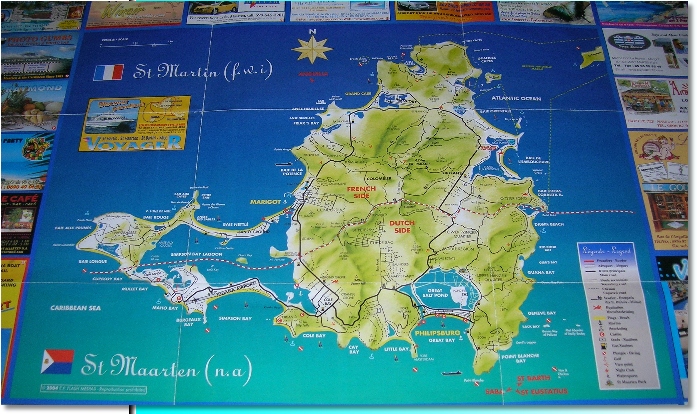
The Dutch side is where the cruise ships dock and where most of the shopping is, while the French side has great restaurants – as you might expect – and some beaches, and is overall a bit less populated. While we’ve come to the Caribbean to get ‘away from it all’, it is nice every once in awhile to land in a place where you have your choice of numerous ‘normal’ sized grocery stores as well as three major hardware stores (one as large as a Home Depot), and many smaller stores that carry every type of general merchandise you might need. St Martin benefits from great cargo ship connections and the selection and pricing is good. Sometimes I wonder why we even bother buying beer and lugging it back to the boat and wrestling to keep it cold when you can walk the streets of Philipsburg and buy an icy cold bottle of beer for $1-$1.25 and stroll down the street with it. There’s no open container law here! It was the same scenario on Saba. Leroy gave me a tour around the island the night before our tow, but not until we stopped at the local dockside pub for a couple cold ones and then hopped into the car. At first it seems all together mischievous, but once you get used to it, it is as natural as anything else. We weren’t there long enough to get a read on the amount of drunk driving, but the lax laws down here certainly make you think twice. I haven’t signed a waiver form or any other legalese-type document since we were state-side with the Carib1500. I’m not saying the U.S. should abandon its laws and its lawyers, but it does make you stop and acknowledge that the U.S. way of doing things isn’t the only way to establish a peaceful society.
Well, before I get ensnared in a political discussion, I’ll change subjects to something much more benign, but fundamental, to our lives — our rudder. After quickly dropping the rudder on the day we were hauled, the marina staff started an autopsy and prompted found out the real reason we lost steerage. The rudder post was turning freely inside the rudder because the three stainless steel bars which run horizontally through the rudder and are welded to the rudder post had all broken at the welds. We also discovered that the rudder was entirely constructed of wood, apart from a thin layer of fiberglass laminate on the outside. The yard manager here, a sprightly South African named Graham – who talks and acts just like my good South African high school friend Deon – was highly critical of the rudder’s construction. While I could have pursued ordering a new rudder from Jeanneau’s factory in France – with a long lead time and great expense to get here – I went with Graham’s plan for them to build up an entirely new rudder in their shop. They would use the original rudder shaft, but with a welded matrix of stainless steel bars that would make it far stronger. Here’s a picture after their machine shop finished with it.
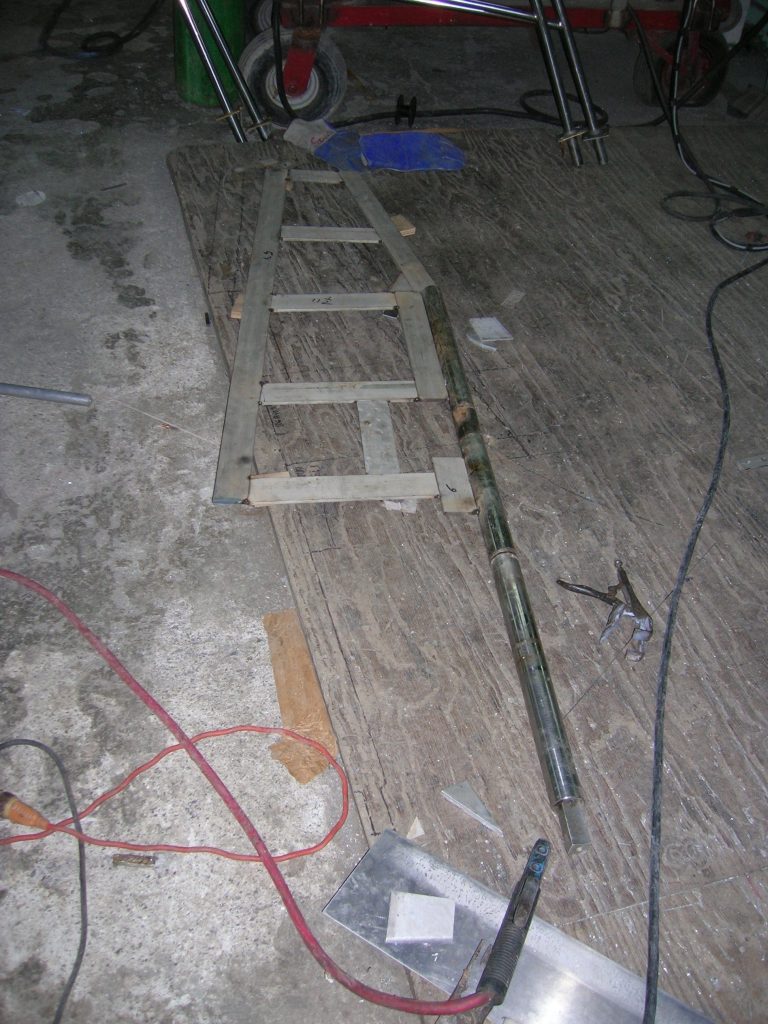
They are now making up a mold using the old rudder as a template and will put this rudder shaft into the mold, inject the whole thing with high density foam, and then cover the outside with a thick series of fiberglass laminates. The yard technicians are all very helpful and genuine people, but like anything, a little nudging each day is needed to keep progress going on our work instead of someone else’s latest emergency. At this point, we are hoping to be back in the water by the middle of next week.
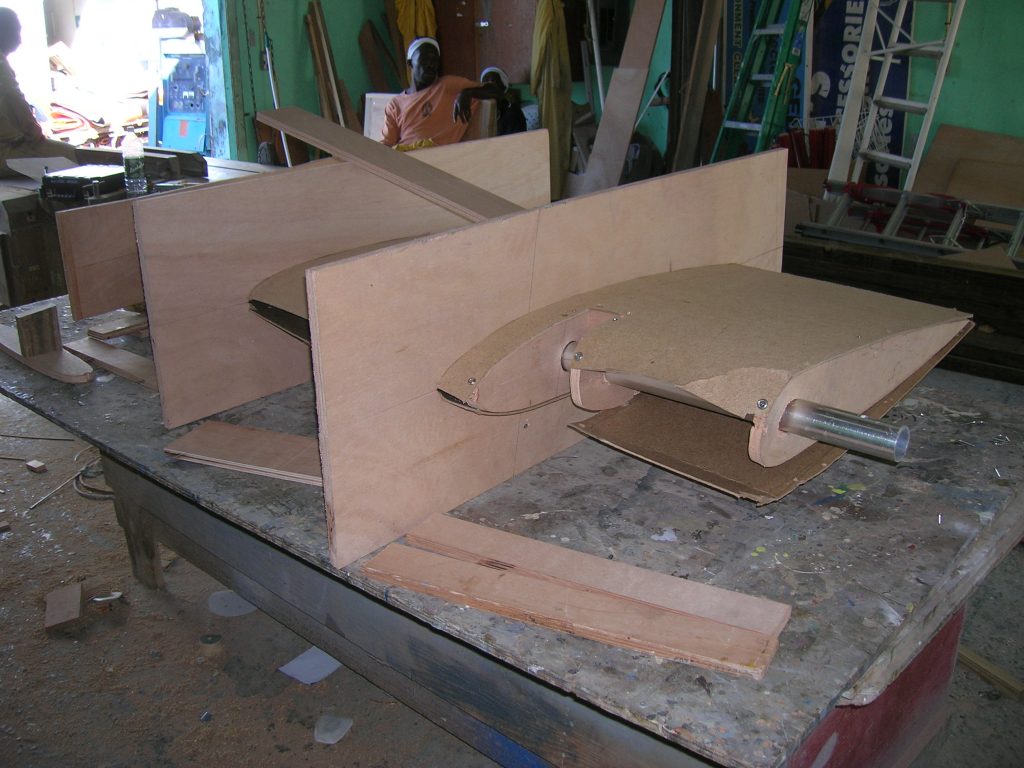
In the meantime, we are by no means idle or bored. We’ve taken this opportunity to spruce up Thalia and she’s looking better then she ever was! Our work has included the boys varnishing the teak trim on the deck.
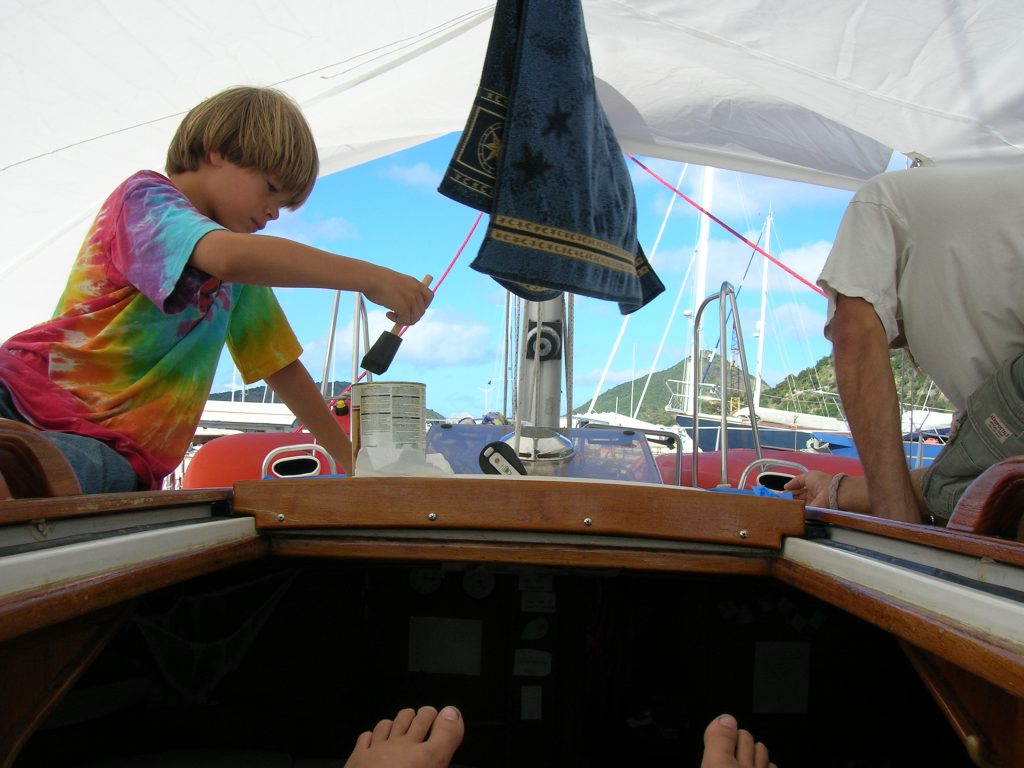
We have also compounded and waxed the hull, put a fresh coat of bottom paint on, and repaired the floor of the cockpit with urgently needed fiberglass reinforcement. The bugs can be a nuisance here on land at night, and Karen has been busy putting up mosquito netting around the hatches and portholes. Still, we’ve had some fun times exploring the island via the local bus service. We enjoyed an incredible dinner at Marigot on the French side……
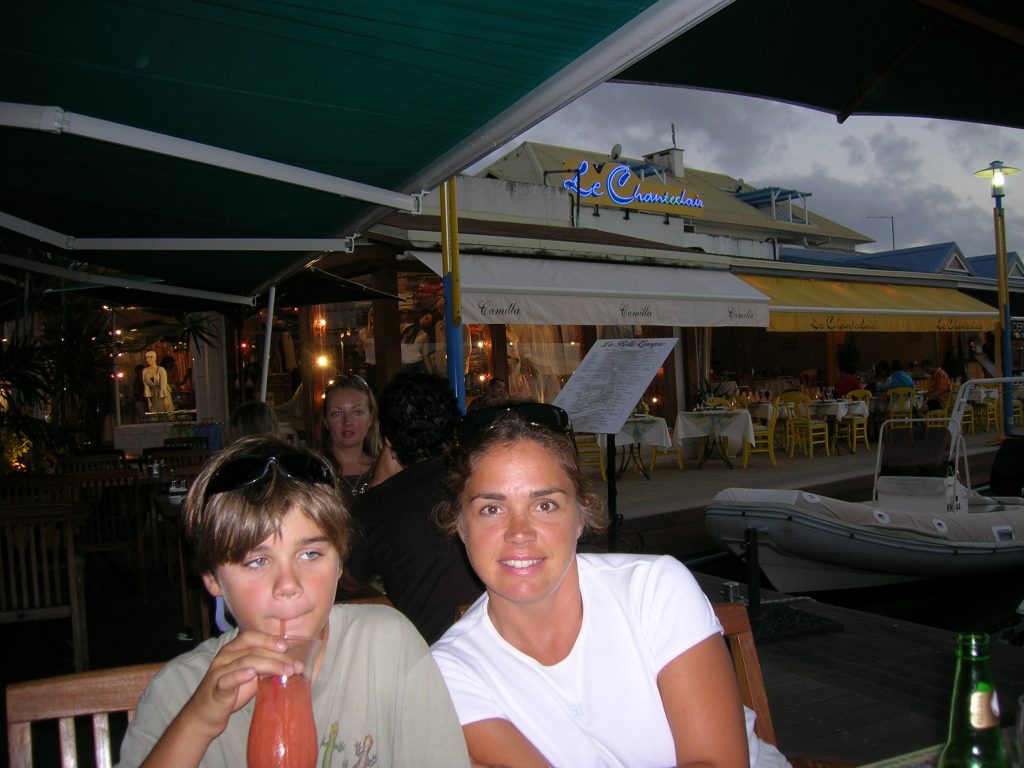
and fresh home cooked Caribbean spiny lobster (much bigger then the Maine variety, but without claws).
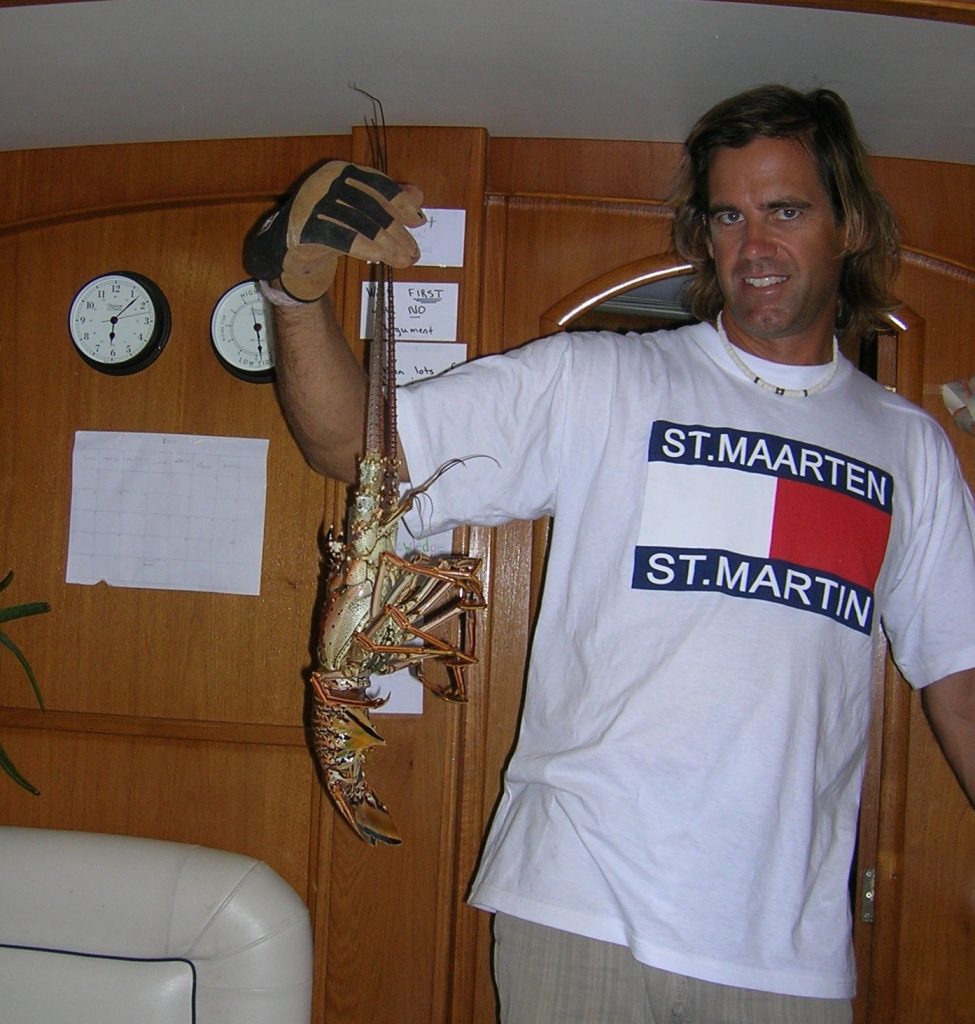
The lobster was the gift of Leroy, whom we enjoyed seeing again on his Friday return to St Martin to sell his weekly catch. We stood in awe at the dock as he unloaded his catch of red snapper, lobster and wahoo, plus those of other fisherman on Saba. He was carrying over 50 of these 50+ lb bags of fish and lobster! There is something remarkably simple and pure about the free marketplace dynamics that occur as a fisherman unloads his catch to a waiting crowd of distributors and restaurateurs.
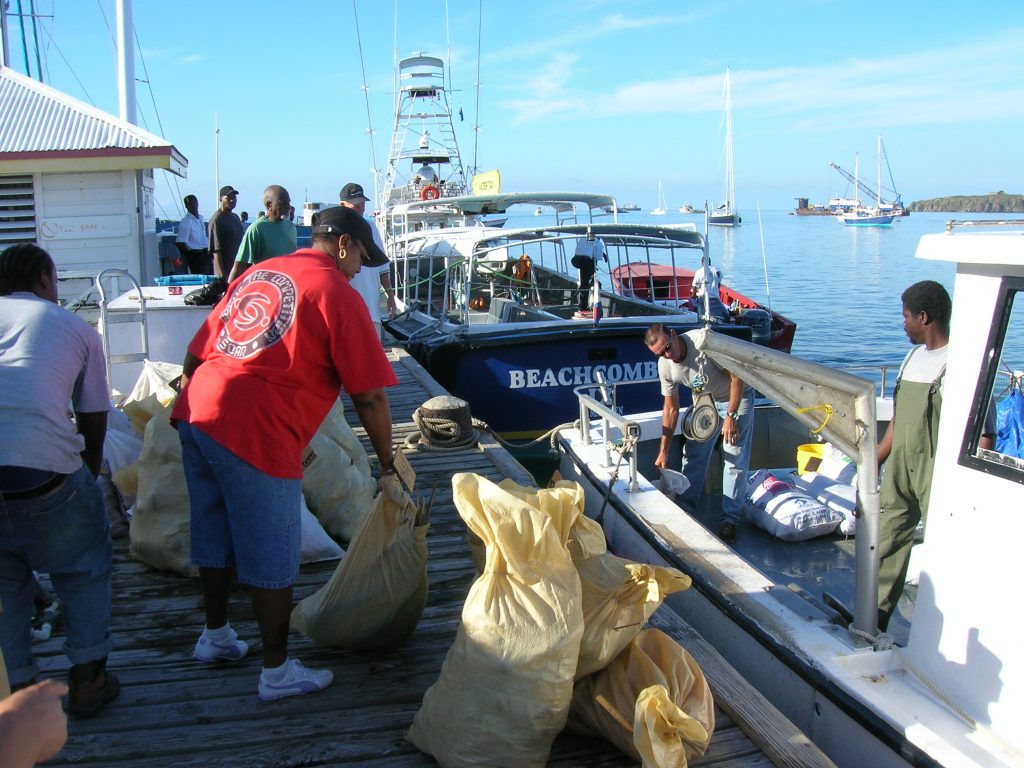
As the evening ends, and we climb the ladder to our home out of the water, it gives us time to pause and reflect on our situation.
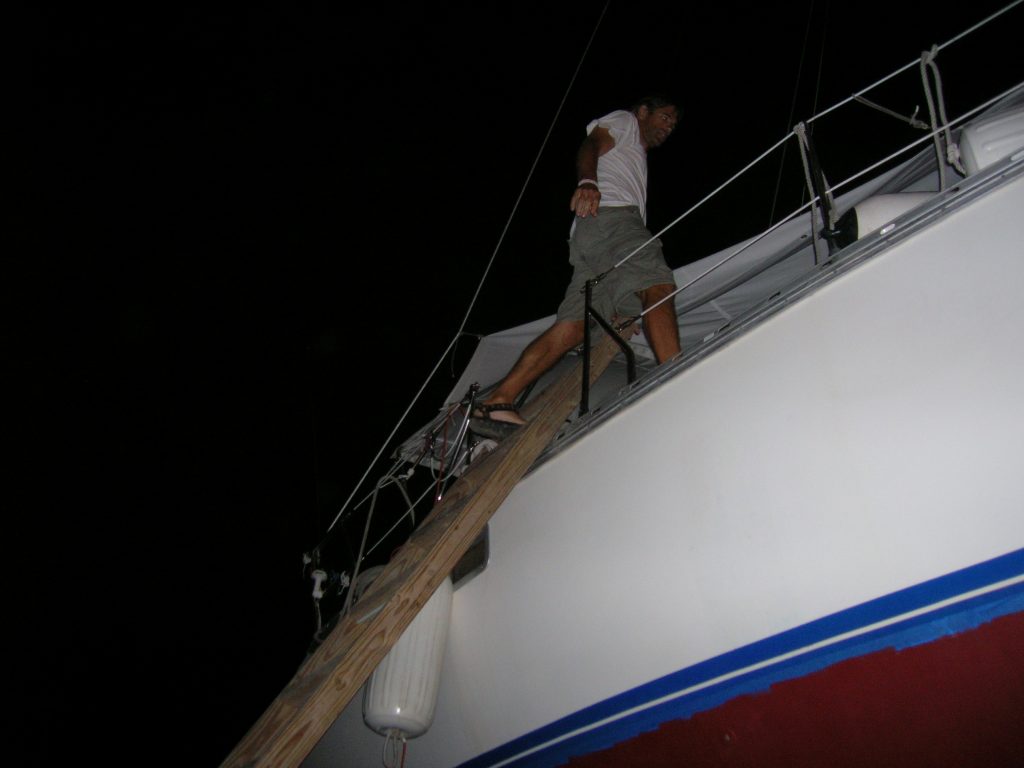
All in all, we’ve had a good week. We have taken in some much needed rest, we’ve brought some of the hidden beauty in Thalia back to life, and we are fortunate to be in the good, capable hands of the marina to complete our new rudder. We keep thinking back about how worse we could have had it and what challenges would have played out if the rudder had broken at any one of a million other easily imaginable but frightfully alarming times, and we consider ourselves very, very lucky to be here. Thinking back on how, in the best case, we would have had an immense physical struggle to sail the boat to safety without a rudder, and the worst case of having to abandon the boat and risk our own personal safety, there is no other boat repair bill I’d happily pay for than this new rudder.
We hope to share the news of us getting underway again next week. Until then, we wish you, your loved ones, your family, your pets and your local school teacher the very best for another grand week. Take care!
